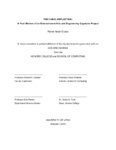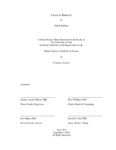TO
1 - 25 of 18
| Creator | Title | Description | Subject | Date | ||
|---|---|---|---|---|---|---|
| 1 |
 |
Sivo, Jacob | Agile in the Wild - An in-Depth look into EAE Student Development Practice | There have been works produced on Agile techniques and their e#11;ectiveness in terms of both actual project progress as well as human factors, especially in industry. There are many training programs that companies enroll their employees in, such as ASPE. In these training programs, individuals are... | 2019 | |
| 2 |
 |
Meier, John E. | An evaluation of the quality of contemporary ray tracing methods on architectural materials | Predictive computer graphics can be used to visualize the appearance of an object or scene from a virtual design. A seminal experiment in that field was performed in 1984 to evaluate the perceptual quality of computer graphics images with a physical model of the scene. The original study was limited... | Ray tracing algorithms | 2009-05 |
| 3 |
 |
Eccles, Patrick Nolan | The Cabal reflection: A post mortem of an entertainment arts and engineering capstone project | This document will serve as Patrick Eccles' Honors Thesis at the University of Utah and will reflect upon the process and result of his and his team members' senior project within the Entertainment Arts and Engineering program: the 3D Puzzle Platformer A Divided Light . On the senior project team, P... | Computer games - Design; Cabal Process | 2015-08 |
| 4 |
 |
Redman, Simon | Critical Reroute | Due to network failure, underprovisioning, or temporary unanticipated increases in traffic, networks may become overloaded. In such situations, it may be desirable to prioritize some traffic flows over others, such as for public safety applications or priority customers. Solutions such as priority q... | 2018 | |
| 5 |
 |
Bracken, Kallie | Defining learning: mystifying machine learning as a powerful tool in a data-driven world | Until recently, the driving paradigm in software engineering has been to design applications for a predefined set of tasks. This approach, however, is quickly being dwarfed by data-driven applications which are designed to use knowledge and understanding to decide how they can best fulfill use... | Machine learning - Case studies; Machine learning - Study and Teaching; Machine Learning - Technique | 2016-04 |
| 6 |
 |
Machado, Liam | Extending Support for Floating-Points in the Boogie and Smack Software Verifiers | Software verification, which aims to prove critical properties about programs using rigorous formal methods based on logic, is an active area of research in the field of computer science. In particular, the veri#12;cation of floating-points is a topic of paramount importance, given their ubiquity ac... | Boogie's; verification; floating- point | 2019 |
| 7 |
 |
Zhang, Conan | Fund Raising Game Development Through Crowdfunding | This paper seeks to formally review and evaluate a Kickstarter campaign launched by a team of five students at the University of Utah. First, an introduction to the topic and its environment is outlined to clarify where the project came from. Next, an overview of the product's design and development... | 2017 | |
| 8 |
 |
Herbert-Voss, Ariel | Generating audio mixtures using deep convolutional neural networks | Deep neural networks have recently been used in a generative capacity to separate and convolve the content and style of two input images. This is done using a joint cost function during gradient descent that encodes information about style and content to iteratively calculate forward node activation... | Computer sound processing; Computer music; Machine learning; Neural networks; Audio mixtures; Spectrograms; Split integer scaling | 2016-05 |
| 9 |
 |
Goller, Nicholas | Iterative game development: What goes into making an effective game and the lessons learned from making two games | Imagine you are told you have two semesters to make a game. You have a team of over ten people ready to help out. You even have the basic idea of what the game will be about. How hard can it be? Well, it is not that hard to make "a game" in two semesters. A competent coder can hack together a game... | Computer games - Design | 2016-04 |
| 10 |
 |
Van der Merwe, Mark | Learning 3D Reconstructions for Geometrically aware Robotic Grasping | Robotic grasping is a crucial subtask of many important robotic applications, such as in-home robotic assistance, emergency responce robots, and industrial robotics. Deep learning has enabled remarkable improvements in robotic grasp synthesis for previously unseen objects from partial object views. ... | 2020 | |
| 11 |
 |
Potter, Hannah | Lifting Coach: Using Machine Learning to Battle Musculoskeletal Damage | Many manual laborers develop musculoskeletal disorders performing their work duties. The prevalence of these issues is concerning because of the negative effects on workers' health and well-being, the great cost to workers who are not able to work temporarily or permanently, and the great cost to co... | Random; normalized | 2019 |
| 12 |
 |
Yehle, Tobin | Memoized parsing with derivatives | Due to the computational complexity of parsing, constituent parsing is not preferred for tasks involving large corpora. However, the high similarity between sentences in natural language suggests that it is not necessary to pay the full computational price for each new sentence. In this work we p... | Parsing (Computer grammar) | 2016-04 |
| 13 |
 |
Nelson, Jennifer | Partial-Order Ambiguous Observations of Fluents and Actions for Goal Recognition as Planning | This work readies goal recognition for real-world scenarios by adapting a foundational compilation by Ram´ırez and Geffner to work with partial-order, ambiguous observations of both facts and actions. We first redefine what observations can be and what it means to satisfy them. We provide a compil... | 2020 | |
| 14 |
 |
Chen, Jiahui | Practical and Configurable Network Traffic Classification using Probabilistic Machine Learning | Network traffic classification that is generally applicable and highly accurate is extremely valuable for many network security and management tasks. A flexible and easily configurable classification framework is ideal so it can be customized for use in many different networks. In this thesis we pro... | 2020 | |
| 15 |
 |
Blackburn, Alexander | Replicating Musical Style: Data-Driven Algorithmic Melody Composition | This thesis describes a novel technique to algorithmic composition which combines two data structures-an N-gram language model and an association network-with a user friendly interface meant for music producers. The MelodySmith is a music composition tool which incorporates this logic into a product... | 2018 | |
| 16 |
 |
Anderson, Sheyne | Sinap types a run-time language for data-description | Sinap IDE is an editor for graph-based programming languages (as distinct from textbased). To facilitate versatility in Sinap IDE it was necessary to design a language (Sinap's Type System) to generically describe families of well-formed cyclic data structures. This language can be used to maintain ... | 2017 | |
| 17 |
 |
Sunkaraneni, Tarun | Transformer-Based Observers in Psychotherapy | Motivational Interviewing is a style of psychotherapy which has shown success as a method for treating addiction and substance abuse problems. In recent years, Natural Language Processing (NLP) techniques have shown promising results in assisting Motivational Interviewing (MI) training and advancing... | 2020 | |
| 18 |
 |
Delacenserie, Jessica | Utilizing classroom technology to strengthen elementary education | There is a disconnect in the current education system where there is an abundance of technology accessible to students but it is not being used in a way that enhances their education. The majority of software currently used in primary schools simply transfers books, homework assignments, etc. to mob... | Education, Elementary; Computer-assisted instruction; Education - Effect of technological innovations on | 2016-05 |
1 - 25 of 18
